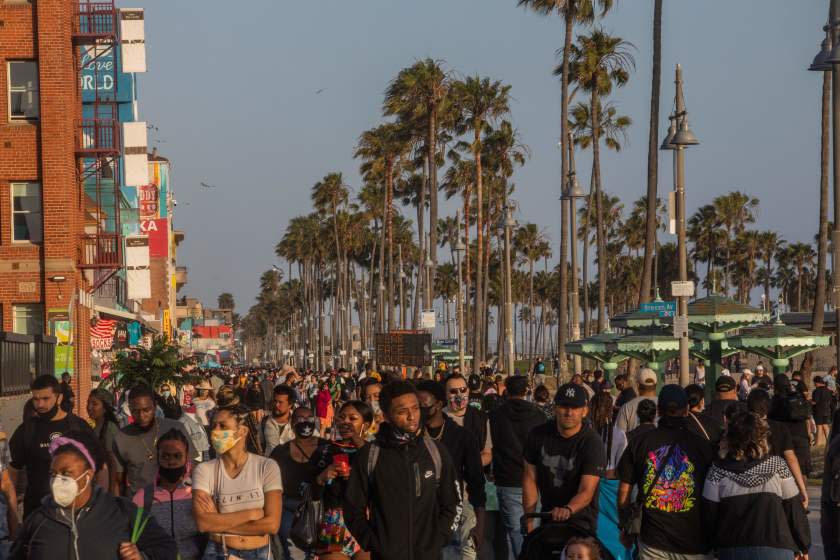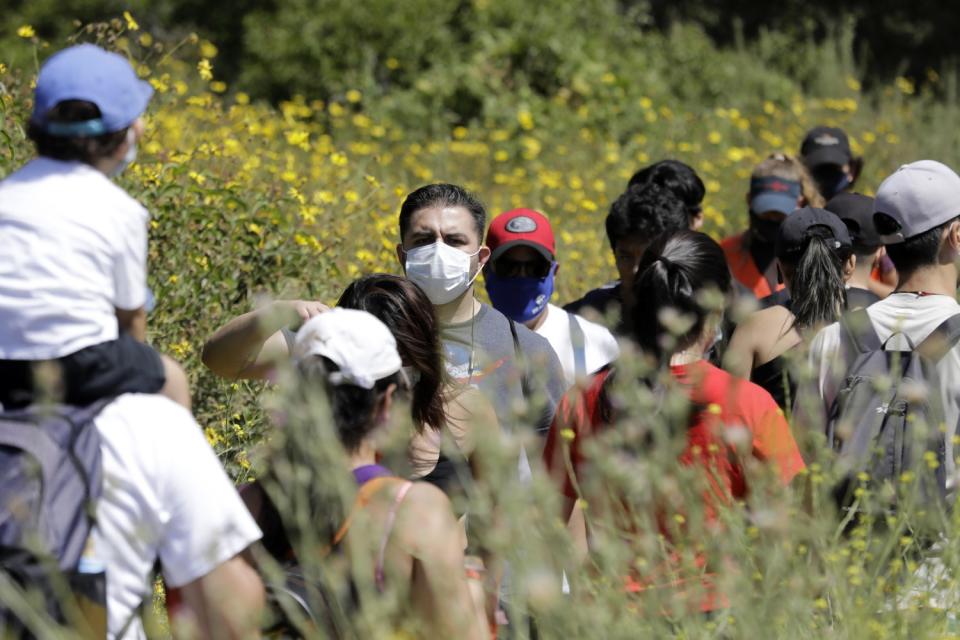A silent coronavirus threat looms large as California reopens businesses

At Eaton Canyon, a popular Pasadena hiking area, so many people crowded the trail Saturday morning — many without masks and jammed close together — that rangers shut it down for the rest of the month.
On the Venice boardwalk, social distancing was in short supply as thousands converged on the beach-side mecca for Memorial Day weekend. Photos of the crowds made national headlines and brought concern from officials who had urged beachgoers to wear masks and keep at least six feet apart.
Both scenes offered a window into the challenges ahead as officials try to slowly ease stay-at-home regulations and reopen the economy while also maintaining safety rules aimed at preventing new COVID-19 outbreaks.
Since the coronavirus crisis began, officials have been concerned about "silent spreaders," people who have the virus but do not show symptoms. They could be strolling along Ocean Front Walk or marching up a hiking trail and look perfectly healthy — but still pass along the virus that causes COVID-19 to others.
Officials have been reopening public spaces, businesses and other institutions at a rapid clip over the last couple of days. Los Angeles County officials announced that retail stores and religious institutions could reopen, with safety restrictions on how many people could be inside at one time.
Experts said that as the stay-at-home order is relaxed, observing such restrictions is going to be essential to prevent silent spreaders from causing new outbreaks.
“Without having social distancing, we are going to definitely see some increased spikes and transmission occurring. That’s definitely going to happen,” said Dr. Robert Kim-Farley, epidemiologist and infectious-disease expert at the UCLA Fielding School of Public Health.
Venice and Eaton Canyon were not necessarily representative of how well social distancing went during the holiday. Lifeguards at beaches in Los Angeles and Orange counties said they did not see major problems and that for the most part people followed rules.

Officials hope residents will continue to cooperate and warn that further reopenings depend on it.
“Reopening does not mean going back to business as usual," Los Angeles County Supervisor Hilda Solis said Tuesday. "As long as community members follow safety rules, we can continue to make more progress."
The U.S. Centers for Disease Control and Prevention estimates that there’s a 20% to 50% chance that those infected with the coronavirus never show major symptoms during their infection. Asymptomatic people may be just as capable of transmitting the disease as infected people who become visibly sick, the CDC said.
People can also transmit the coronavirus days before they show signs of sickness. This is what scientists call "presymptomatic transmission."
Of 402 residents and workers testing positive for the coronavirus at Los Angeles County nursing homes, 345 had no symptoms of illness, Los Angeles County Department of Public Health Director Barbara Ferrer said last week. In other words, 86% of people testing positive at scores of skilled nursing facilities across the nation’s most populous counties had no symptoms of the disease when they were tested.
This is not the only study to raise concerns about the large numbers of presymptomatic or asymptomatic infected people. A UC San Francisco study conducted in late April found that, among several thousand residents and workers in San Francisco’s Mission District, 62 tested positive for COVID-19 — but more than half of them, 53%, had no symptoms at the time they were tested.
An editorial in the New England Journal of Medicine in late April called asymptomatic transmission “the Achilles’ heel of COVID-19 pandemic control through the public health strategies we have currently deployed.”
In another study, also published in the New England Journal of Medicine, 56% of residents at a skilled nursing facility in Washington state’s King County who initially tested positive showed no symptoms at the time, but most of them later did show signs of illness. It took a median of four days for them to show symptoms.
Visibly healthy people can be omitted from efforts aimed at trying to identify infected people, such as attempting to screen incoming airline passengers from overseas.
Further, a silent spreader can transmit the coronavirus simply by talking. Loud talking can emit thousands of saliva droplets per second, and researchers recently found that, in a stagnant air environment, droplets of fluid sprayed from the mouth remained in the air for as long as eight to 14 minutes before drying up.
“These observations confirm that there is a substantial probability that normal speaking causes airborne virus transmission in confined environments,” said the authors in a study published May 13 by the Proceedings of the National Academy of Sciences.
That’s why it’s so important to adhere to social distancing and wearing masks, experts say.
“What we’re really trying to do is prevent transmission from talking,” said Dr. George Rutherford, an epidemiology and infectious-disease expert at UC San Francisco, last week. “We’re trying to ... prevent people who are asymptomatically infected from transmitting.”
It’s easier to suffocate a disease in which the symptoms are obvious, and in which infectiousness occurs after symptoms show up, said Kim-Farley, the UCLA epidemiologist. For instance, there are few asymptomatic cases of measles, and officials can identify cases, isolate them, find the infected person’s close contacts and quarantine them, snuffing out an outbreak.
But diseases in which there’s a large share of asymptomatic cases can be far harder to deal with. For instance, for every 100 people who were infected with polio, only about one fell ill with paralysis, Kim-Farley said.
“So it’s highly asymptomatic. So that’s why you really can’t do contact tracing for polio, because for every case that you identify that has symptoms, there are 99 others that don’t. So it’s silently spread in the community.”
That’s why, in the years before the polio vaccine was available on a large scale in the mid-1950s, many parents kept their children at home, even in the summer, when the spread of the virus seemed to peak. Polio was once one of the nation’s most feared diseases, crippling more than 35,000 people a year, on average.
Dr. Deborah Birx, the White House’s coronavirus response coordinator, said the problem of silent spreaders makes it all the more important that testing be done widely, especially in vulnerable places like nursing homes, meatpacking plants and agricultural fields, and that people wear masks when they can't stay six feet away from others.
“What I’m worried about is: What are we putting in place to find asymptomatic cases?” Birx said Sunday on ABC News. “All of this proactive testing needs to be in place — and needs to continue to be in place — because that will determine safely remaining open in the fall.”
Experts expect a second surge of coronavirus cases starting in the fall, which may be made worse by the simultaneous start of the flu season.
As of Tuesday night, there were more than 3,800 coronavirus deaths reported in California — 56% of which have occurred among L.A. County residents. Nationally, more than 98,000 deaths have been reported.
Over the Memorial Day weekend, there were no major reported problems with excessive crowds in the San Francisco Bay Area. San Francisco recently painted 10-foot-diameter circles in the grass at four city parks to help groups keep away from one another. Uniformed people staffed Mission Dolores Park to distribute masks to park guests.
But in Los Angeles County, officials lamented the crowds at the Venice Beach boardwalk, where few were wearing masks in images shared on social media.
“The issues this weekend validate our decision to keep our county parking lots at Venice Beach closed,” said Nicole Mooradian, spokeswoman for L.A. County’s Department of Beaches and Harbors.
NO @GavinNewsom This is not #Florida. I took this today an hour ago at #Venice #Beach and 98% of the people are not wearing masks including food workers. There are police everywhere and not one is in forcing anything. We paid $20 to park, saw this and left immediately. pic.twitter.com/FrLje7r7LU
— DanteTheComic (@Dantethecomic) May 24, 2020
Times staff writer Sarah Parvini contributed to this report.

